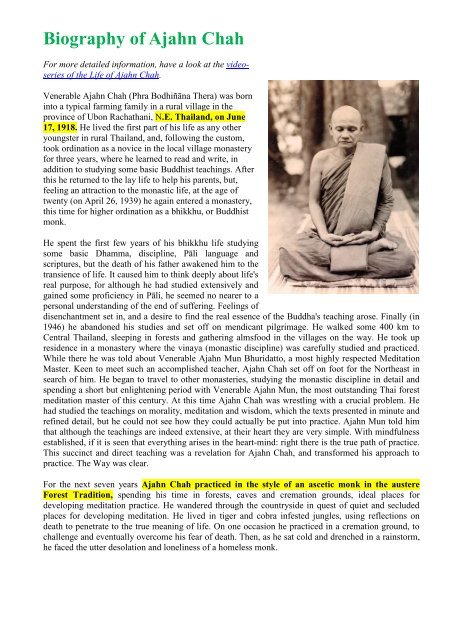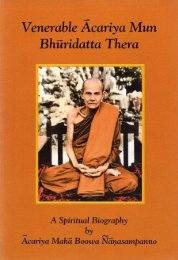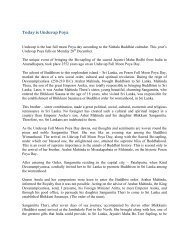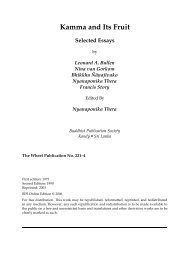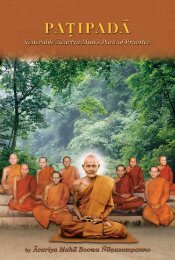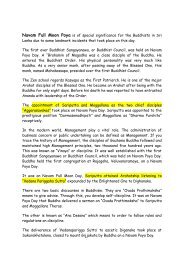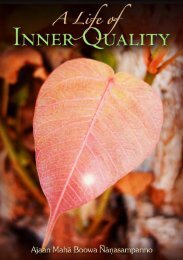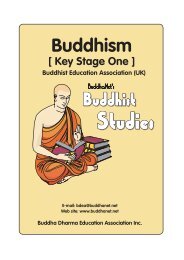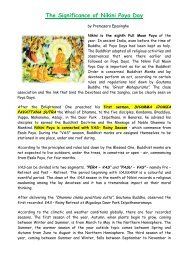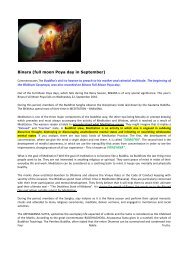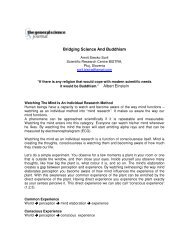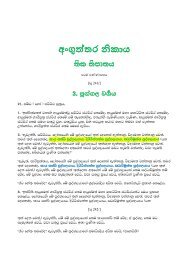You also want an ePaper? Increase the reach of your titles
YUMPU automatically turns print PDFs into web optimized ePapers that Google loves.
<strong>Biography</strong> <strong>of</strong> <strong>Ajahn</strong> <strong>Chah</strong>For more detailed information, have a look at the videoseries<strong>of</strong> the Life <strong>of</strong> <strong>Ajahn</strong> <strong>Chah</strong>.Venerable <strong>Ajahn</strong> <strong>Chah</strong> (Phra Bodhiñāna Thera) was borninto a typical farming family in a rural village in theprovince <strong>of</strong> Ubon Rachathani, N.E. Thailand, on June17, 1918. He lived the first part <strong>of</strong> his life as any otheryoungster in rural Thailand, and, following the custom,took ordination as a novice in the local village monasteryfor three years, where he learned to read and write, inaddition to studying some basic Buddhist teachings. Afterthis he returned to the lay life to help his parents, but,feeling an attraction to the monastic life, at the age <strong>of</strong>twenty (on April 26, 1939) he again entered a monastery,this time for higher ordination as a bhikkhu, or Buddhistmonk.He spent the first few years <strong>of</strong> his bhikkhu life studyingsome basic Dhamma, discipline, Pāli language andscriptures, but the death <strong>of</strong> his father awakened him to thetransience <strong>of</strong> life. It caused him to think deeply about life'sreal purpose, for although he had studied extensively andgained some pr<strong>of</strong>iciency in Pāli, he seemed no nearer to apersonal understanding <strong>of</strong> the end <strong>of</strong> suffering. Feelings <strong>of</strong>disenchantment set in, and a desire to find the real essence <strong>of</strong> the Buddha's teaching arose. Finally (in1946) he abandoned his studies and set <strong>of</strong>f on mendicant pilgrimage. He walked some 400 km toCentral Thailand, sleeping in forests and gathering almsfood in the villages on the way. He took upresidence in a monastery where the vinaya (monastic discipline) was carefully studied and practiced.While there he was told about Venerable <strong>Ajahn</strong> Mun Bhuridatto, a most highly respected MeditationMaster. Keen to meet such an accomplished teacher, <strong>Ajahn</strong> <strong>Chah</strong> set <strong>of</strong>f on foot for the Northeast insearch <strong>of</strong> him. He began to travel to other monasteries, studying the monastic discipline in detail andspending a short but enlightening period with Venerable <strong>Ajahn</strong> Mun, the most outstanding Thai forestmeditation master <strong>of</strong> this century. At this time <strong>Ajahn</strong> <strong>Chah</strong> was wrestling with a crucial problem. Hehad studied the teachings on morality, meditation and wisdom, which the texts presented in minute andrefined detail, but he could not see how they could actually be put into practice. <strong>Ajahn</strong> Mun told himthat although the teachings are indeed extensive, at their heart they are very simple. With mindfulnessestablished, if it is seen that everything arises in the heart-mind: right there is the true path <strong>of</strong> practice.This succinct and direct teaching was a revelation for <strong>Ajahn</strong> <strong>Chah</strong>, and transformed his approach topractice. The Way was clear.For the next seven years <strong>Ajahn</strong> <strong>Chah</strong> practiced in the style <strong>of</strong> an ascetic monk in the austereForest Tradition, spending his time in forests, caves and cremation grounds, ideal places fordeveloping meditation practice. He wandered through the countryside in quest <strong>of</strong> quiet and secludedplaces for developing meditation. He lived in tiger and cobra infested jungles, using reflections ondeath to penetrate to the true meaning <strong>of</strong> life. On one occasion he practiced in a cremation ground, tochallenge and eventually overcome his fear <strong>of</strong> death. Then, as he sat cold and drenched in a rainstorm,he faced the utter desolation and loneliness <strong>of</strong> a homeless monk.
After many years <strong>of</strong> travel and practice, hewas invited to settle in a thick forest grovenear the village <strong>of</strong> his birth. This grove wasuninhabited, known as a place <strong>of</strong> cobras,tigers and ghosts, thus being as he said, theperfect location for a forest monk. Venerable<strong>Ajahn</strong> <strong>Chah</strong>'s impeccable approach tomeditation, or Dhamma practice, and hissimple, direct style <strong>of</strong> teaching, with theemphasis on practical application and abalanced attitude, began to attract a largefollowing <strong>of</strong> monks and lay people. Thus alarge monastery formed around <strong>Ajahn</strong> <strong>Chah</strong>as more and more monks, nuns and laypeoplecame to hear his teachings and stayon to practice with him.<strong>Ajahn</strong> <strong>Chah</strong>'s simple yet pr<strong>of</strong>ound style <strong>of</strong> teaching has a special appeal to Westerners, and many havecome to study and practice with him, quite a few for many years. In 1966 the first westerner came tostay at Wat Nong Pah Pong, Venerable Sumedho Bhikkhu. The newly ordained Venerable Sumedhohad just spent his first vassa ('Rains' retreat) practicing intensive meditation at a monastery near theLaotian border. Although his efforts had borne some fruit, Venerable Sumedho realized that he neededa teacher who could train him in all aspects <strong>of</strong> monastic life. By chance, one <strong>of</strong> <strong>Ajahn</strong> <strong>Chah</strong>'s monks,one who happened to speak a little English visited the monastery where Venerable Sumedho wasstaying. Upon hearing about <strong>Ajahn</strong> <strong>Chah</strong>, he asked to take leave <strong>of</strong> his preceptor, and went back toWat Nong Pah Pong with the monk. <strong>Ajahn</strong> <strong>Chah</strong> willingly accepted the new disciple, but insisted thathe receive no special allowances for being a Westerner. He would have to eat the same simplealmsfood and practice in the same way as any other monk at Wat Nong Pah Pong. The training therewas quite harsh and forbidding. <strong>Ajahn</strong> <strong>Chah</strong> <strong>of</strong>ten pushed his monks to their limits, to test their powers<strong>of</strong> endurance so that they would develop patience and resolution. He sometimes initiated long andseemingly pointless work projects, in order to frustrate their attachment to tranquility. The emphasiswas always on surrender to the way things are, and great stress was placed upon strict observance <strong>of</strong>the vinaya.From that time on, the number <strong>of</strong> foreign people whocame to <strong>Ajahn</strong> <strong>Chah</strong> began to steadily increase. By thetime Venerable Sumedho was a monk <strong>of</strong> five vassas, and<strong>Ajahn</strong> <strong>Chah</strong> considered him competent enough to teach,some <strong>of</strong> these new monks had also decided to stay on andtrain there. In the hot season <strong>of</strong> 1975, Venerable Sumedhoand a handful <strong>of</strong> Western bhikkhus spent some time livingin a forest not far from Wat Nong Pah Pong. The localvillagers there asked them to stay on, and <strong>Ajahn</strong> <strong>Chah</strong>consented. The Wat Pah Nanachat ('International ForestMonastery') came into being, and Venerable Sumedhobecame the abbot <strong>of</strong> the first monastery in Thailand to berun by and for English-speaking monks.In 1977, <strong>Ajahn</strong> <strong>Chah</strong> and <strong>Ajahn</strong> Sumedho were invited tovisit Britain by the English Sangha Trust, a charity with theaim <strong>of</strong> establishing a locally-resident Buddhist Sangha.Seeing the serious interest there, <strong>Ajahn</strong> <strong>Chah</strong> left <strong>Ajahn</strong>Sumedho (with two <strong>of</strong> his other Western disciples whowere then visiting Europe) in London at the Hampstead
Vihara. He returned to Britain in 1979, at which time the monks were leaving London to beginChithurst Buddhist Monastery in Sussex. He then went on to America and Canada to visit and teach.In 1980 Venerable <strong>Ajahn</strong> <strong>Chah</strong> began to feel more accutely the symptoms <strong>of</strong> dizziness and memorylapse which had plagued him for some years. In 1980 and 1981, <strong>Ajahn</strong> <strong>Chah</strong> spent the 'rains retreat'away from Wat Nong Pah Pong, since his health was failing due to the debilitating effects <strong>of</strong> diabetes.As his illness worsened, he would use his body as a teaching, a living example <strong>of</strong> the impermanence <strong>of</strong>all things. He constantly reminded people to endeavor to find a true refuge within themselves, since hewould not be able to teach for very much longer. This led to an operation in 1981, which, however,failed to reverse the onset <strong>of</strong> the paralysis which eventually rendered him completely bedridden andunable to speak. This did not stop the growth <strong>of</strong> monks and lay people who came to practise at hismonastery, however, for whom the teachings <strong>of</strong> <strong>Ajahn</strong> <strong>Chah</strong> were a constant guide and inspiration.After remaining bedridden and silent for an amazing ten years, carefully tended by his monks andnovices, Venerable <strong>Ajahn</strong> <strong>Chah</strong> passed away on the 16th <strong>of</strong> January, 1992, at the age <strong>of</strong> 74,leaving behind a thriving community <strong>of</strong> monasteries and lay suporters in Thailand, England,Switzerland, Italy, France, Australia, New Zealand, Canada and the U.S.A, where the practise <strong>of</strong> theBuddha's teachings continues under the inspiration <strong>of</strong> this great meditation teacher.Although <strong>Ajahn</strong> <strong>Chah</strong> passed away in 1992, the training which he established is still carried on at WatNong Pah Pong and its branch monasteries, <strong>of</strong> which there are currently more than two hundred inThailand. Discipline is strict, enabling one to lead a simple and pure life in a harmoniously regulatedcommunity where virtue, meditation and understanding may be skillfully and continuously cultivated.There is usually group meditation twice a day and sometimes a talk by the senior teacher, but the heart<strong>of</strong> the meditation is the way <strong>of</strong> life. The monastics do manual work, dye and sew their own robes,make most <strong>of</strong> their own requisites and keep the monastery buildings and grounds in immaculate shape.They live extremely simply following the ascetic precepts <strong>of</strong> eating once a day from the almsbowl andlimiting their possessions and robes. Scattered throughout the forest are individual huts where monksand nuns live and meditate in solitude, and where they practice walking meditation on cleared pathsunder the trees.Wisdom is a way <strong>of</strong> living and being, and <strong>Ajahn</strong><strong>Chah</strong> has endeavored to preserve the simplemonastic life-style in order that people may studyand practice the Dhamma in the present day.<strong>Ajahn</strong> <strong>Chah</strong>'s wonderfully simple style <strong>of</strong>teaching can be deceptive. It is <strong>of</strong>ten only afterwe have heard something many times thatsuddenly our minds are ripe and somehow theteaching takes on a much deeper meaning. Hisskillful means in tailoring his explanations <strong>of</strong>Dhamma to time and place, and to theunderstanding and sensitivity <strong>of</strong> his audience,was marvelous to see. Sometimes on paperthough, it can make him seem inconsistent oreven self-contradictory! At such times the reader should remember that these words are a record <strong>of</strong> aliving experience. Similarly, if the teachings may seem to vary at times from tradition, it should beborne in mind that the Venerable <strong>Ajahn</strong> spoke always from the heart, from the depths <strong>of</strong> his ownmeditative experience.


